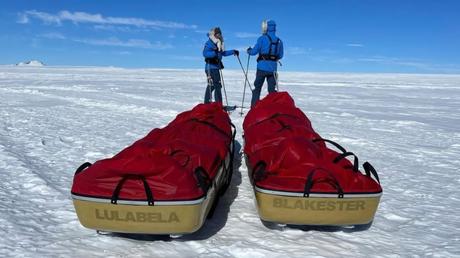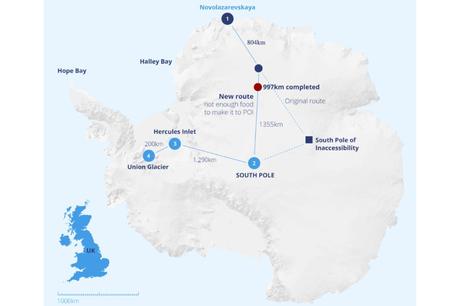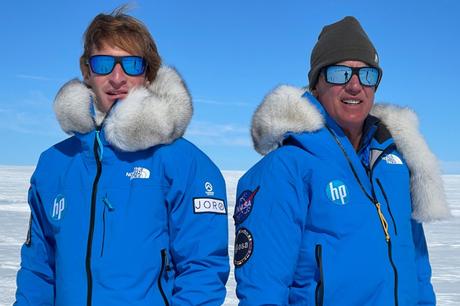Last year, thanks to the COVID pandemic, the Antarctic expedition season was cancalled altogether. This year, solo skiers and teams of adventurers are returning to the frozen continent, looking to chase their dreams of skiing to the South Pole, climbing Mt. Vinson, or pursuing some other major goal. But after nearly two years without visitors, the Antarctic hasn't been all that accommodating, as a pair of British explorers is finding out.

Chasing the Light
Veteran adventurers Justin Packshaw and Jamie Facer Childs set off on what they call the Chasing the Light expedition back on November 11. The duo began their ambitious journey the Russian Novolazarevskaya Station with some enormously challenging goals in mind. Using skis and kites, they hoped to cover more than 4200 km (2609 miles) in 80 days, traveling through one of the most desolate, difficult, and unforgiving regions of the planet.
Originally, the idea was to go from Novo Station to Antarctic South Pole of Inaccessbility, which would have covered 1770 km (1100 miles) alone. After that, the plan was to turn to the geographic South Pole, which sits approximately 900 km (560 miles) from the POI. That wouldn't be the team's finish line, however, as they also planned to ski 1290 km (802 miles) to Hercules Inlet, before reaching their final destination at Union Glacier, another 200 km (124 miles) away.
Unfortunately, things haven't been going as expected and Packshaw and Facer Childs have already had to alter those plans. Because surface conditions have not been as favorable as they would like-and the winds haven't cooperated with their kites-the duo are moving slower than expected. As a result, they've now given up on their idea of reaching the POI and have turned towards 90ºS instead.

The Antarctic Pole of Inaccessibility
Most people know about the Geographic South Pole and the Magnetic South Pole, but what exactly is the Pole of Inaccessibility? The POI is defined as the location on the Antarctic continent that is equal distant from all coastlines. Depending on how you measure where those coastlines begin, the exact spot is located at either at 82°06′S 54°58′E or 83°06′S 54°58′E. Most view it as the former, with the discrepencie coming from whether or not you believe the Antarctic coast begins at the ice or where the land sits underneath it.
Every continent and ocean has a POI, but few are as difficult to reach as the one in Antarctica. The journey is harsh, even during the Austral summer. Over the past month, Packshaw and Facer Childs have experienced winds reaching speeds of 160 km/h (100 mph) and temperatures dropping below -40ºC/F. Those conditions are found on routes to the Geographic South Pole as well, but that is a more well-known route that sees civilian traffic from November to January each year.
Those harsh conditions have eaten into the team's schedule. A few days back, they took a look at their dwindling supplies and calculated their speed and decided it was best to give up the POI and turn south instead. They're now making their way to the South Pole and have covered a little more than 1000 km (621 miles).

The Chasing the Light expedition has other goals beyond just reaching certain points on the map. Packshaw and Facer Childs have several impressive sponsors backing them, with NASA, the European Space Agency, and Standford Univerity all following their endeavor closely.
As with other explorers, the boys are collecting all kinds of data on the current climate in Antarctica. They're also studying the impact of such a long and difficult journey on the body and mind, while working with techniques designed to keep them focused and in good spirits throughout. The physical toll that such an expedition can put on the body is fairly well documented, but the effects it has on the brain are less understood.
One of the reasons NASA and the ESA are so invested in the expedition is that they expect it to offer insights into how astornauts would perform on a long journey as well. Specifically, they are studying the psychological effects it could have on someone traveling to Mars or on the planet's surface. As such, Packshaw and Facer Childs's pulse rate, number of calories burned, stress levels, and sleep patterns are all being montiored closely.
A Long Way to Go
Despite abandoning their attempt to reach the Pole of Inaccessibility, the Chasing the Light team still has a long way to go before they are done. It will be interesting to see if they continue on after reaching the South Pole, whcih as of this writing is still 1300 km (807 miles) away. That's a lot of ground to cover over the next few weeks, particularly if they want to complete the leg back to Hercules Inlet and Union Glacier.
Fortunately, we can all follow along, as they are posting daily updates to the expedition website. You'll also find real-time data on their current heart rates, stress, levels and other factors too. That should make this a fascinating adventure to watch unfold, particularly for those of us who didn't have any Antarctic expeditions to follow last year.
Follow along at ChasingTheLight2021.com.



